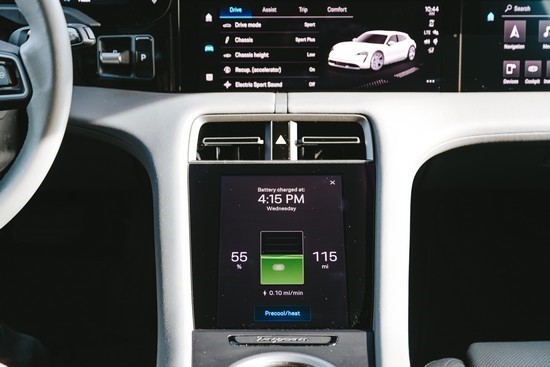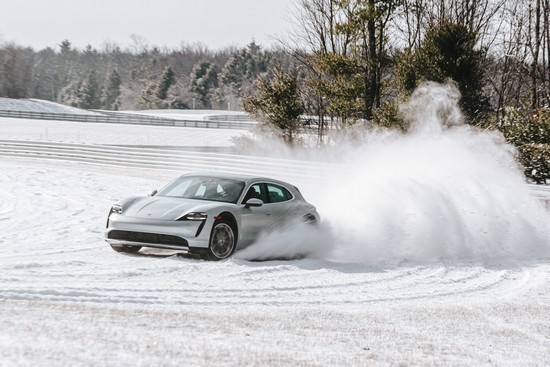As far
as we can tell,
Henry Ford and other auto pioneers made no attempt to imitate
the nostalgic clopping of hooves or the smell of, er, hay.
اضافة اعلان
But even as
automakers look to wean drivers off internal combustion, they are not
abandoning valuable brand signatures honed over decades — the look, feel, or
even sounds of “old tech” analog cars. Think the muscle-car cues of
Ford’s
electric Mustang Mach-E or the relentless scrutiny of towing capacity and other
truck-stop bona fides for the Ford F-150 Lightning.
Then there are the
new
Porsche Taycan Cross Turismo and Audi RS e-Tron GT. These precocious
siblings, which I drove and charged in New York, share a Volkswagen Group
parent. Furthermore, they share a corporate “J1” electric platform and much of
their formidable powertrains.
At first glance,
the cars do not appear genetically related. The Porsche is the Peter Parker
dream of every station wagon nerd, combining up to 750 all-wheel-drive
horsepower with uncanny grip and superhero handling. The e-Tron GT is a
smoldering, broad-shouldered autobahn sedan with up to 637 horses of its own.
 The electric Porsche Taycan Cross Turismo. (Photo: NYTimes)
The electric Porsche Taycan Cross Turismo. (Photo: NYTimes)
These cars are
priced beyond typical means; the most affordable Taycan Cross Turismo can be
had for $95,050, and the lowest you will pay for the e-Tron GT is $103,445. Yet
both offer hopeful evidence of how long-standing brands might shape-shift into
electric automakers without becoming unrecognizable to paying customers.
Porsche Taycan 4S
Cross Turismo
The 2020
Taycan sedan was the brand’s first modern all-electric showroom
vehicle, but its vivid performance reminded people that Porsche was no newbie.
Ferdinand Porsche designed his first electric car in 1898, followed by the
race-winning Lohner-Porsche Electromobile in 1900. Ludwig Lohner, his
development partner, credited inspiration to air that was “ruthlessly spoiled
by the large number of petrol engines in use.”
After Porsche put
its $845,000 918 Spyder Hybrid on the street in 2013, a racing 919 Hybrid
reeled off three straight 24 Hours of LeMans wins. You can feel all that racing
and engineering heritage trickle into the Taycan Cross Turismo and straight
into your fingertips. Sedan or wagon, this remains the industry’s
sweetest-handling, most fun-to-drive EV, even if it is slower in a straight
line than the $131,000 Tesla Model S Plaid.
Some enthusiasts
may be confounded by the long-roofed style of a Porsche wagon. To iconoclasts
who still love them — count me in — the
Cross Turismo will seem a beautiful,
magic sleigh. Like another all-weather wagon that trolled brand traditionalists
— the discontinued Ferrari GTC4Lusso — the Porsche becomes the new fantasy car
for Instagram ski trips, only with zero tailpipe emissions to befoul the slopes
of Aspen or Gstaad.
Versus the sedan,
the body is lifted by around 2cm. A selectable air suspension can jack things
up to Subaru heights, via a “Gravel” mode that optimizes the all-wheel-drive
system, suspension, and other parameters for slippery conditions. My version
was a 4S, starting from $111,650 and reaching $136,300 with options.
 Screens on the dash and console of an electric Porsche Taycan Cross Turismo. (Photo: NYTimes)
Screens on the dash and console of an electric Porsche Taycan Cross Turismo. (Photo: NYTimes)
As with the Audi,
the Porsche’s stingy, 346km rated range is its weakest feature. The Taycan has
proved its ability to exceed that official range in the real world by 80 or so
kilometers, but that is not happening in brutal winter temperatures. With not
enough stamina for the 354km round trip from Brooklyn, I had to plan a charging
stop in Newburgh, New York.
At least charging
is fast. The Taycan introduced a powerful 800-volt architecture, versus Tesla’s
400 volts (and now surpassed by Lucid’s 900-volt Air sedan). That helps the
Porsche slurp juice at a maximum 270-kilowatt pace, allowing refills to 80
percent capacity in about 22 minutes. That requires a 350-kilowatt charger like
the one in Newburgh — part of the
Volkswagen-funded Electrify America network.
They are expanding their footprint but remain scarce versus Tesla
Superchargers.
Even though the
charger pushed 150 kilowatts rather than 270 (cold again a likely culprit), the
Porsche added 6.5 miles of range for every plugged-in minute. Over 40 minutes,
including a charging ramp-down to preserve battery life, my estimated range
rose to 337km, from around 73km.
Audi RS e-Tron GT
Perhaps more than any luxury maker,
Audi has pushed to make its EVs
reassuring and accessible: The e-Trons are Audis first, electric cars second.
The original e-Tron SUVs, especially, will pass for the same Audis that haunt
every fair-trade coffee roaster and school pickup queue in America.
 (Photo: NYTimes)
(Photo: NYTimes)
The e-Tron GT
maintains that philosophy, subsuming its electric tech under a voluptuous
grand-tourer body and a comforting blanket of Audi luxury. Only this time, it
is impossible to ignore the monsters below, which awaken with every prod of
your right foot: dual electric motors that peak at 637 horsepower in the RS
version. The next thing you know, the monster devours 60 mph, a 3.1-second
uprising that leaves you hanging on for dear life. Thank goodness for massive,
optional carbon-ceramic brakes, their forceful poise welcome on fast,
mini-Alpine descents in the Hudson Valley.
Add the Audi and
Porsche to a growing list of 2.5-tonne electric sedans with wild acceleration.
The RS e-Tron immediately becomes history’s most-powerful Audi, topping two
gasoline stablemates also sired by Papa VW: the R8 V-10 and
Lamborghini Huracán
supercars. The Audi GT costs less, although that is relative, starting from
$103,445. That rises to $140,945 for the RS version and $161,890 for my heavily
optioned RS.
EVs have turned
minimalist, screen-centric interiors — often in monochromatic tones — into a
design cliche. But the
e-Tron GT integrates modern tech, including striking
“virtual cockpit” displays, with warmth and elegance, another Audi signature it
is not ready to abandon. Artistically bolstered front seats are the Eames
chairs aboard the Enterprise, wrapped in honeycomb-stitched nappa leather or a
herringbone tweed in an animal-free version. The back seat is tight, in the
haughty style of luxury GTs: A passenger ought to feel grateful to get a ride.
That RS ride can
last only so long, with an official 373km Environmental Protection Agency
range, or 383km in the standard version. To its credit, the Audi can replenish
miles with the best of them, with its own 350-kilowatt fast-charge ability. But
let’s hope a forthcoming Porsche-designed “PPE” platform — shared among EVs
including a Macan SUV, an Audi Q6 crossover and a
Bentley — goes easier on
electrons than this Audi’s 80 to 81 mpg-equivalent rating.
 The Taycan and Audi’s RS e-Tron GT, both under the Volkswagen Group umbrella, share a corporate “J1” electric platform, much of their formidable powertrains, and price tags mostly in the six figures.(Photo: NYTimes)
The Taycan and Audi’s RS e-Tron GT, both under the Volkswagen Group umbrella, share a corporate “J1” electric platform, much of their formidable powertrains, and price tags mostly in the six figures.(Photo: NYTimes)
That said, buyers who
choose the Audi or Porsche are most likely adding one to a garage already
groaning with longer-lasting options. For them, these shorter-range missiles
will be a nice problem to have.
Read more Drive




